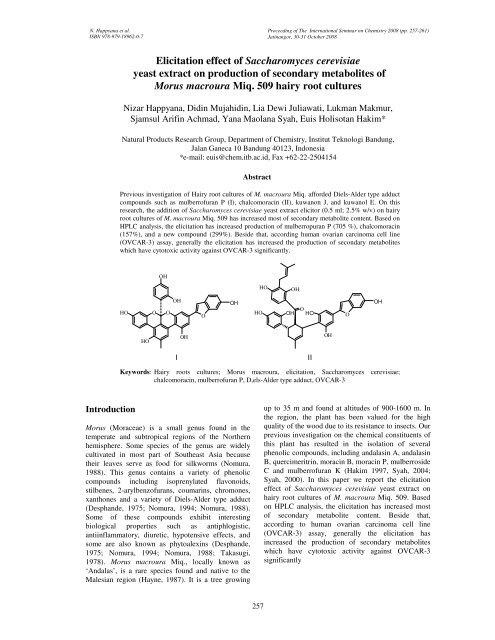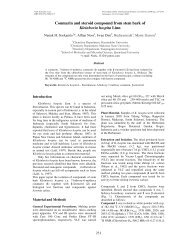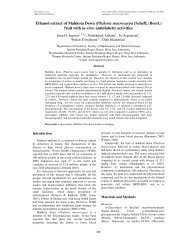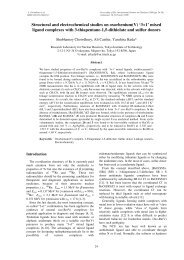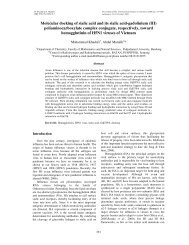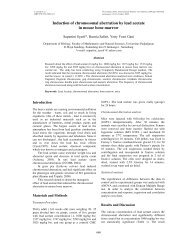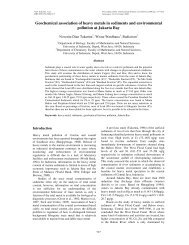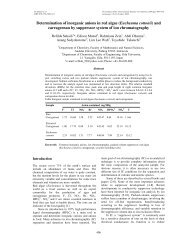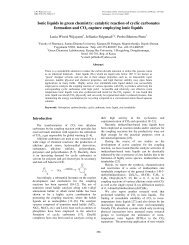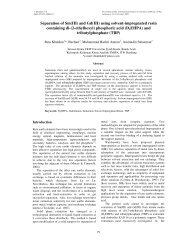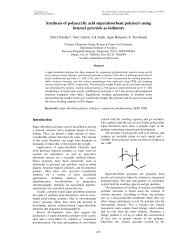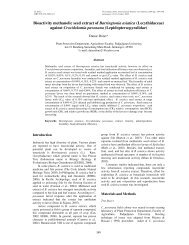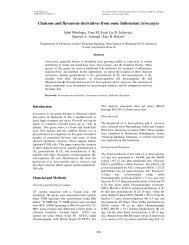Elicitation effect of Saccharomyces cerevisiae yeast extract on ...
Elicitation effect of Saccharomyces cerevisiae yeast extract on ...
Elicitation effect of Saccharomyces cerevisiae yeast extract on ...
- No tags were found...
Create successful ePaper yourself
Turn your PDF publications into a flip-book with our unique Google optimized e-Paper software.
N. Happyana et al. Proceeding <str<strong>on</strong>g>of</str<strong>on</strong>g> The Internati<strong>on</strong>al Seminar <strong>on</strong> Chemistry 2008 (pp. 257-261)ISBN 978-979-18962-0-7Jatinangor, 30-31 October 2008<str<strong>on</strong>g>Elicitati<strong>on</strong></str<strong>on</strong>g> <str<strong>on</strong>g>effect</str<strong>on</strong>g> <str<strong>on</strong>g>of</str<strong>on</strong>g> <str<strong>on</strong>g>Saccharomyces</str<strong>on</strong>g> <str<strong>on</strong>g>cerevisiae</str<strong>on</strong>g><str<strong>on</strong>g>yeast</str<strong>on</strong>g> <str<strong>on</strong>g>extract</str<strong>on</strong>g> <strong>on</strong> producti<strong>on</strong> <str<strong>on</strong>g>of</str<strong>on</strong>g> sec<strong>on</strong>dary metabolites <str<strong>on</strong>g>of</str<strong>on</strong>g>Morus macroura Miq. 509 hairy root culturesNizar Happyana, Didin Mujahidin, Lia Dewi Juliawati, Lukman Makmur,Sjamsul Arifin Achmad, Yana Maolana Syah, Euis Holisotan Hakim*Natural Products Research Group, Department <str<strong>on</strong>g>of</str<strong>on</strong>g> Chemistry, Institut Teknologi Bandung,Jalan Ganeca 10 Bandung 40123, Ind<strong>on</strong>esia*e-mail: euis@chem.itb.ac.id, Fax +62-22-2504154AbstractPrevious investigati<strong>on</strong> <str<strong>on</strong>g>of</str<strong>on</strong>g> Hairy root cultures <str<strong>on</strong>g>of</str<strong>on</strong>g> M. macroura Miq. afforded Diels-Alder type adductcompounds such as mulberr<str<strong>on</strong>g>of</str<strong>on</strong>g>uran P (I), chalcomoracin (II), kuwan<strong>on</strong> J, and kuwanol E. On thisresearch, the additi<strong>on</strong> <str<strong>on</strong>g>of</str<strong>on</strong>g> <str<strong>on</strong>g>Saccharomyces</str<strong>on</strong>g> <str<strong>on</strong>g>cerevisiae</str<strong>on</strong>g> <str<strong>on</strong>g>yeast</str<strong>on</strong>g> <str<strong>on</strong>g>extract</str<strong>on</strong>g> elicitor (0.5 ml; 2.5% w/v) <strong>on</strong> hairyroot cultures <str<strong>on</strong>g>of</str<strong>on</strong>g> M. macroura Miq. 509 has increased most <str<strong>on</strong>g>of</str<strong>on</strong>g> sec<strong>on</strong>dary metabolite c<strong>on</strong>tent. Based <strong>on</strong>HPLC analysis, the elicitati<strong>on</strong> has increased producti<strong>on</strong> <str<strong>on</strong>g>of</str<strong>on</strong>g> mulberropuran P (705 %), chalcomoracin(157%), and a new compound (299%). Beside that, according human ovarian carcinoma cell line(OVCAR-3) assay, generally the elicitati<strong>on</strong> has increased the producti<strong>on</strong> <str<strong>on</strong>g>of</str<strong>on</strong>g> sec<strong>on</strong>dary metaboliteswhich have cytotoxic activity against OVCAR-3 significantly.OHHOOHHOOOOHOOHHOOHOHOOOHHOOHOHI IIKeywords: Hairy roots cultures; Morus macroura, elicitati<strong>on</strong>, <str<strong>on</strong>g>Saccharomyces</str<strong>on</strong>g> <str<strong>on</strong>g>cerevisiae</str<strong>on</strong>g>;chalcomoracin, mulberr<str<strong>on</strong>g>of</str<strong>on</strong>g>uran P, D,els-Alder type adduct, OVCAR-3Introducti<strong>on</strong>Morus (Moraceae) is a small genus found in thetemperate and subtropical regi<strong>on</strong>s <str<strong>on</strong>g>of</str<strong>on</strong>g> the Northernhemisphere. Some species <str<strong>on</strong>g>of</str<strong>on</strong>g> the genus are widelycultivated in most part <str<strong>on</strong>g>of</str<strong>on</strong>g> Southeast Asia becausetheir leaves serve as food for silkworms (Nomura,1988). This genus c<strong>on</strong>tains a variety <str<strong>on</strong>g>of</str<strong>on</strong>g> phenoliccompounds including isoprenylated flav<strong>on</strong>oids,stilbenes, 2-arylbenz<str<strong>on</strong>g>of</str<strong>on</strong>g>urans, coumarins, chrom<strong>on</strong>es,xanth<strong>on</strong>es and a variety <str<strong>on</strong>g>of</str<strong>on</strong>g> Diels-Alder type adduct(Desphande, 1975; Nomura, 1994; Nomura, 1988).Some <str<strong>on</strong>g>of</str<strong>on</strong>g> these compounds exhibit interestingbiological properties such as antiphlogistic,antiinflammatory, diuretic, hypotensive <str<strong>on</strong>g>effect</str<strong>on</strong>g>s, andsome are also known as phytoalexins (Desphande,1975; Nomura, 1994; Nomura, 1988; Takasugi,1978). Morus macroura Miq., locally known as‘Andalas’, is a rare species found and native to theMalesian regi<strong>on</strong> (Hayne, 1987). It is a tree growingup to 35 m and found at altitudes <str<strong>on</strong>g>of</str<strong>on</strong>g> 900-1600 m. Inthe regi<strong>on</strong>, the plant has been valued for the highquality <str<strong>on</strong>g>of</str<strong>on</strong>g> the wood due to its resistance to insects. Ourprevious investigati<strong>on</strong> <strong>on</strong> the chemical c<strong>on</strong>stituents <str<strong>on</strong>g>of</str<strong>on</strong>g>this plant has resulted in the isolati<strong>on</strong> <str<strong>on</strong>g>of</str<strong>on</strong>g> severalphenolic compounds, including andalasin A, andalasinB, quercimeritrin, moracin B, moracin P, mulberrosideC and mulberr<str<strong>on</strong>g>of</str<strong>on</strong>g>uran K (Hakim 1997, Syah, 2004;Syah, 2000). In this paper we report the elicitati<strong>on</strong><str<strong>on</strong>g>effect</str<strong>on</strong>g> <str<strong>on</strong>g>of</str<strong>on</strong>g> <str<strong>on</strong>g>Saccharomyces</str<strong>on</strong>g> <str<strong>on</strong>g>cerevisiae</str<strong>on</strong>g> <str<strong>on</strong>g>yeast</str<strong>on</strong>g> <str<strong>on</strong>g>extract</str<strong>on</strong>g> <strong>on</strong>hairy root cultures <str<strong>on</strong>g>of</str<strong>on</strong>g> M. macroura Miq. 509. Based<strong>on</strong> HPLC analysis, the elicitati<strong>on</strong> has increased most<str<strong>on</strong>g>of</str<strong>on</strong>g> sec<strong>on</strong>dary metabolite c<strong>on</strong>tent. Beside that,according to human ovarian carcinoma cell line(OVCAR-3) assay, generally the elicitati<strong>on</strong> hasincreased the producti<strong>on</strong> <str<strong>on</strong>g>of</str<strong>on</strong>g> sec<strong>on</strong>dary metaboliteswhich have cytotoxic activity against OVCAR-3significantly257
N. Happyana et al. Proceeding <str<strong>on</strong>g>of</str<strong>on</strong>g> The Internati<strong>on</strong>al Seminar <strong>on</strong> Chemistry 2008 (pp. 257-261)Jatinangor, 30-31 October 2008Materials and MethodsGeneral experimental proceduresOptical rotati<strong>on</strong>s were determined using a Perkin-Elmer 141 polarimeter. UV spectra were performed<strong>on</strong> a Varian Corry 100 C<strong>on</strong>c spectrometer. FTIRspectra were carried out <strong>on</strong> a Perkin Elmer spectrumOne FTIR as a film <strong>on</strong> a KBr plate. NMR spectrawere recorded <strong>on</strong> JEOL JNM A 5000 at 400 MHz( 1 H) and 100 MHz ( 13 C). VLC and radialchromatography were carried out using Merck Si gel60 GF254 and, for TLC analysis, precoated Si gelplates (Merck Kieselgel 60 GF254, 0.25 mm) wereused.Plant and material1. M. macroura Miq. 509 hairy root culturesTransformati<strong>on</strong> <str<strong>on</strong>g>of</str<strong>on</strong>g> the M. macroura Miq. nucleus byAgrobacterium rhizogenes 509 has assisted byBiotechnology Laboratory, Ind<strong>on</strong>esian Institute <str<strong>on</strong>g>of</str<strong>on</strong>g>Sciences. The cultures <str<strong>on</strong>g>of</str<strong>on</strong>g> M. macroura Miq. 509were grown in 50 ml liquid medium <str<strong>on</strong>g>of</str<strong>on</strong>g> MurashigeSkoog (MS) with 0.5 ppm <str<strong>on</strong>g>of</str<strong>on</strong>g> indol-3-buteric acid(IBA) and shaken at 100 rpm at room temperarure.The subculture was carried out every 4 weeks. Theadditi<strong>on</strong> <str<strong>on</strong>g>of</str<strong>on</strong>g> 0.5 ml <str<strong>on</strong>g>Saccharomyces</str<strong>on</strong>g> <str<strong>on</strong>g>cerevisiae</str<strong>on</strong>g> <str<strong>on</strong>g>yeast</str<strong>on</strong>g><str<strong>on</strong>g>extract</str<strong>on</strong>g> elicitor (2.5% w/v) was carried out when thehairy root cultures reach the age <str<strong>on</strong>g>of</str<strong>on</strong>g> 8 weeks, then theywere incubated for 7 days and harvested.2. Cultures <str<strong>on</strong>g>of</str<strong>on</strong>g> S. <str<strong>on</strong>g>cerevisiae</str<strong>on</strong>g>S. <str<strong>on</strong>g>cerevisiae</str<strong>on</strong>g> <str<strong>on</strong>g>yeast</str<strong>on</strong>g> was obtained from MicrobiologyLaboratory, School <str<strong>on</strong>g>of</str<strong>on</strong>g> Life Sciences, InstitutTeknologi Bandung. It was grown in 50 ml liquidmedium <str<strong>on</strong>g>of</str<strong>on</strong>g> GYE and shaken at 100 rpm at roomtemperature. The cultures <str<strong>on</strong>g>of</str<strong>on</strong>g> S. <str<strong>on</strong>g>cerevisiae</str<strong>on</strong>g> weresubcultivated every two days by transferring 10 ml <str<strong>on</strong>g>of</str<strong>on</strong>g>the culture into 40 ml <str<strong>on</strong>g>of</str<strong>on</strong>g> the fresh liquid medium. Thecultures were harvested at 16 hours old. Thesupernatants part was removed and the cells weredried and grinded to powders.Extracti<strong>on</strong> and isolati<strong>on</strong>The dried powdered <str<strong>on</strong>g>of</str<strong>on</strong>g> hairy roots <str<strong>on</strong>g>of</str<strong>on</strong>g> M. macrouraMiq. 509 (35 gram) was macerated with MeOH. TheMeOH <str<strong>on</strong>g>extract</str<strong>on</strong>g> was fracti<strong>on</strong>ated by VLC (Si-gel,hexane-EtOAc, 1:1 to 2:8) into 7 fracti<strong>on</strong>s. Thesec<strong>on</strong>d fracti<strong>on</strong> (258 mg) was subjected to silica gelradial chromatography, eluted with hexane : EtOAc(6 : 4) to yield mulberr<str<strong>on</strong>g>of</str<strong>on</strong>g>uran P (I) (21 mg), while thefourth fracti<strong>on</strong> (300 mg) was subjected to silica gelradial chromatography, eluted with hexane: EtOAc(4: 6) to afford chalcomoracin (II) (161 mg). The fifthfracti<strong>on</strong> was successively purified by silica gel radialchromatography (CHCl 3 : MeOH, 9: 1) and flashsilica gel column chromatography (hexane : acet<strong>on</strong>e,6:4) to yield a new compound (5 mg).HPLC analysisHPLC analysis was performed using a Shimadzu-VPsystem (Shimadzu, s’-Hortengenbosch, TheNetherlands) c<strong>on</strong>sisting <str<strong>on</strong>g>of</str<strong>on</strong>g> a LC-10AT pomp, aK<strong>on</strong>tr<strong>on</strong> 360 auto sampler, a SPD-M10A DADdetector, a FCV-10AL low pressure gradient mixer, aSCL-10A system c<strong>on</strong>troller, a FIAtr<strong>on</strong> systems CH-30column heater, operated with CLASS-VP s<str<strong>on</strong>g>of</str<strong>on</strong>g>tware,versi<strong>on</strong> 6.12SP4. The column used was a Licrosphere5 RP-18 (250 x 4 mm; Chrompack, Middelburg, theNetherlands). The injecti<strong>on</strong> volume was 20 µl with aflow rate <str<strong>on</strong>g>of</str<strong>on</strong>g> 1 ml mim -1 using a time program <str<strong>on</strong>g>of</str<strong>on</strong>g> 45minutes. The mobile phase was c<strong>on</strong>sisted <str<strong>on</strong>g>of</str<strong>on</strong>g> Water(0.05% formic acid) (solvent A) and MeCN (0.05%formic acid) (solvent B) and used a linear gradientsystem with given time endpoints: 0.01 min: 5% B; 15min: 30% B; 30 min: 95% B; 35 min: 95% B; 40 min:5% B; and 45 min: 5% B.For HPLC analysis, the sample was prepared withdissolving 1 mg sample in 1 ml methanol, transferredinto a micro tube and closed immediately, andsubjected into a HPLC instrument. This procedure wasalso applied toward the c<strong>on</strong>trol, the sample media, andthe c<strong>on</strong>trol media.Cytotoxic activityThe human ovarian carcinoma cell line (OVCAR-3),at a density <str<strong>on</strong>g>of</str<strong>on</strong>g> 5 x 10 4 cell/ml, was seeded in 96 wellmicroplates and andalasin C (1), mulberr<str<strong>on</strong>g>of</str<strong>on</strong>g>uran P, andchalcomoracin were added to the cell cultures atc<strong>on</strong>centrati<strong>on</strong>s <str<strong>on</strong>g>of</str<strong>on</strong>g> (500–0.98 µg/ml). The cells werethen incubated for 48 h in 5% CO 2 incubator at 37 °Cand MTT soluti<strong>on</strong> was added 4 h before the end <str<strong>on</strong>g>of</str<strong>on</strong>g> theincubati<strong>on</strong> time. Cell survival was evaluated with amultiwell scanning spectrophotometer (Asys Hitec,Expert96, Asys Co. Japan) at 540 nm. All data arepresented as the mean values <str<strong>on</strong>g>of</str<strong>on</strong>g> triplicates.Results and Discussi<strong>on</strong>The MeOH <str<strong>on</strong>g>extract</str<strong>on</strong>g> <str<strong>on</strong>g>of</str<strong>on</strong>g> M. macroura hairy root wasfracti<strong>on</strong>ated with vacuum liquid chromatography intoseven fracti<strong>on</strong>s. Purificati<strong>on</strong> <str<strong>on</strong>g>of</str<strong>on</strong>g> the sec<strong>on</strong>d fracti<strong>on</strong>yielded mulberr<str<strong>on</strong>g>of</str<strong>on</strong>g>uran P (I) (Hano, 1986) while thefourth and the fifth fracti<strong>on</strong>s successively affordedchalcomoracin (II) (Takasugi, 1988) and a newcompound. The structures <str<strong>on</strong>g>of</str<strong>on</strong>g> these compounds weredetermined based <strong>on</strong> spectroscopic data including UV,IR, NMR, and MS spectra.In this research, 0.5 ml <str<strong>on</strong>g>of</str<strong>on</strong>g> S. <str<strong>on</strong>g>cerevisiae</str<strong>on</strong>g> <str<strong>on</strong>g>yeast</str<strong>on</strong>g> <str<strong>on</strong>g>extract</str<strong>on</strong>g>elicitor (2.5% w/v) was added into M. macroura Miq509 hairy root cultures which has achieved thestati<strong>on</strong>ary phase (8 weeks), and then it was incubated258
N. Happyana et al. Proceeding <str<strong>on</strong>g>of</str<strong>on</strong>g> The Internati<strong>on</strong>al Seminar <strong>on</strong> Chemistry 2008 (pp. 257-261)Jatinangor, 30-31 October 2008for 7 days. The <str<strong>on</strong>g>effect</str<strong>on</strong>g> <str<strong>on</strong>g>of</str<strong>on</strong>g> the elicitor additi<strong>on</strong> wasanalyzed by HPLC measurements and bioactivityassay (OVCAR-3 assay) toward the sample, thec<strong>on</strong>trol, sample media, and c<strong>on</strong>trol media.Some compounds <strong>on</strong> the sample were producedwith higher quantity than the c<strong>on</strong>trol (see table I andfigure I). The quantity <str<strong>on</strong>g>of</str<strong>on</strong>g> compounds E, H and I <strong>on</strong>the sample, significantly higher quantity (1327%,1088%, and 2333%) than <strong>on</strong> the c<strong>on</strong>trol. Besidesthose, compounds A, C, F, G (new compound), J, K(mulberr<str<strong>on</strong>g>of</str<strong>on</strong>g>uran P), N (chalcomoracin), P and Q wereproduced with higher quantity as well (236%, 139%,258%, 400%, 258%, 705%, 157%, 296%, and267%). All <str<strong>on</strong>g>of</str<strong>on</strong>g> these indicated that the additi<strong>on</strong> <str<strong>on</strong>g>of</str<strong>on</strong>g> theelicitor stimulated the increasing <str<strong>on</strong>g>of</str<strong>on</strong>g> some sec<strong>on</strong>darymetabolites producti<strong>on</strong>s.Nevertheless, compounds L, O, and U <strong>on</strong> thesample were produced lower quantity (44%, 65%,and 42%) than <strong>on</strong> the c<strong>on</strong>trol (see table I and figureI). Furthermore, the additi<strong>on</strong> <str<strong>on</strong>g>of</str<strong>on</strong>g> the elicitor inhibitedcompound B producti<strong>on</strong>. It indicated that the additi<strong>on</strong><str<strong>on</strong>g>of</str<strong>on</strong>g> the elicitor decreasing some sec<strong>on</strong>dary metabolitesproducti<strong>on</strong>s.According to the table I and figure II, there weresignificantly differences between the sample mediaand the c<strong>on</strong>trol media <str<strong>on</strong>g>of</str<strong>on</strong>g> M. macroura Miq 509 hairyroot cultures. All compounds <strong>on</strong> the sample mediapossessed higher quantity than <strong>on</strong> the c<strong>on</strong>trol. Thecompounds which were secreted by hairy roots <str<strong>on</strong>g>of</str<strong>on</strong>g> M.macroura Miq 509 into the sample media with higherquantity than into the c<strong>on</strong>trol media, were compoundsC, E, F, G, H, I, J, K, N, P, Q, S, and T (133%, 131%,548%, 500%, 284%, 2110%, 454%, 392%, 699%,238%, 208%, 173%). Beside that, there was acompound which was <strong>on</strong>ly secreted by the samplemedia, namely compound R. Nevertheless,compounds D and U were <strong>on</strong>ly secreted into thec<strong>on</strong>trol media. All <str<strong>on</strong>g>of</str<strong>on</strong>g> these indicated that the additi<strong>on</strong><str<strong>on</strong>g>of</str<strong>on</strong>g> S. <str<strong>on</strong>g>cerevisiae</str<strong>on</strong>g> <str<strong>on</strong>g>yeast</str<strong>on</strong>g> <str<strong>on</strong>g>extract</str<strong>on</strong>g> elicitor stimulated M.macroura Miq 509 hairy root cultures to secret somecompounds into the sample media with higher quantitythan into the c<strong>on</strong>trol media, and to block the releasing<str<strong>on</strong>g>of</str<strong>on</strong>g> the other compounds (compounds D and U).Based <strong>on</strong> OVCAR-3 assay, IC 50 value <str<strong>on</strong>g>of</str<strong>on</strong>g> thesample against OVCAR-3 was 49 µg/ml and thec<strong>on</strong>trol was 102 µg/ml (see figures IV.33 and IV.34).Therefore, the sample showed higher activity valueagainst OVCAR-3 than the c<strong>on</strong>trol, and it mean thatthe additi<strong>on</strong> <str<strong>on</strong>g>of</str<strong>on</strong>g> the elicitor increased the activity <str<strong>on</strong>g>of</str<strong>on</strong>g> thesample <str<strong>on</strong>g>of</str<strong>on</strong>g> M. macroura Miq 509 hairy roots againstOVCAR-3. The increase <str<strong>on</strong>g>of</str<strong>on</strong>g> this activity probablycaused by the increase <str<strong>on</strong>g>of</str<strong>on</strong>g> sec<strong>on</strong>dary metabolitesproducti<strong>on</strong> which have activity against OVCAR-3.C<strong>on</strong>trolSampleFigure1 Choromatogram comparis<strong>on</strong> <str<strong>on</strong>g>of</str<strong>on</strong>g> the sample and the c<strong>on</strong>trol.259
N. Happyana et al. Proceeding <str<strong>on</strong>g>of</str<strong>on</strong>g> The Internati<strong>on</strong>al Seminar <strong>on</strong> Chemistry 2008 (pp. 257-261)Jatinangor, 30-31 October 2008C<strong>on</strong>trolmediaSamplemediaFigure 2 Chromatogram comparis<strong>on</strong> <str<strong>on</strong>g>of</str<strong>on</strong>g> the sample media and the c<strong>on</strong>trol mediaTable 1 Comparis<strong>on</strong> <str<strong>on</strong>g>of</str<strong>on</strong>g> HPLC chromatogram peak area for analysis <str<strong>on</strong>g>of</str<strong>on</strong>g> the <str<strong>on</strong>g>effect</str<strong>on</strong>g> <str<strong>on</strong>g>of</str<strong>on</strong>g> elicitati<strong>on</strong> <str<strong>on</strong>g>of</str<strong>on</strong>g> S. <str<strong>on</strong>g>cerevisiae</str<strong>on</strong>g><str<strong>on</strong>g>yeast</str<strong>on</strong>g> <str<strong>on</strong>g>extract</str<strong>on</strong>g> elicitor toward producti<strong>on</strong> <str<strong>on</strong>g>of</str<strong>on</strong>g> sec<strong>on</strong>dary metabolites <str<strong>on</strong>g>of</str<strong>on</strong>g> M. macroura Miq 509 hairy rootculturesCompoundsRetenti<strong>on</strong> timePeak Area (mAU)(minutes) Sample C<strong>on</strong>trol Sample media C<strong>on</strong>trol mediaA 10.987 3484 1475B 14.315 8793C 25.792 7507 5367 12968 9726D 26.411 7069 2310E 26.741 49053 3694 7361 5585F 26.976 29641 7410 26176 4772G (new compound) 27.672 24244 8082 33768 6753H 28.224 15594 1432 2512 628I 28.469 172364 7388 36839 12950J 28.789 9546 3694 100492 4762K (mulberr<str<strong>on</strong>g>of</str<strong>on</strong>g>uran P) 29.045 136973 19407 84005 18484L 29.237 2576 5768N (chalcomoracin) 30.197 360453 228515 364330 92929O 31.168 22213 33667 14822 8481P 32.075 32853 11082 22203 3173Q 33.897 9152 3425 3665 1537R 20.8 10381S 23.589 7393 3554T 24.233 3693 2129U 29.696 2765 6455 1581260
N. Happyana et al. Proceeding <str<strong>on</strong>g>of</str<strong>on</strong>g> The Internati<strong>on</strong>al Seminar <strong>on</strong> Chemistry 2008 (pp. 257-261)Jatinangor, 30-31 October 2008C<strong>on</strong>clusi<strong>on</strong>sThe ellicitati<strong>on</strong> <str<strong>on</strong>g>of</str<strong>on</strong>g> <str<strong>on</strong>g>Saccharomyces</str<strong>on</strong>g> <str<strong>on</strong>g>cerevisiae</str<strong>on</strong>g> <str<strong>on</strong>g>yeast</str<strong>on</strong>g><str<strong>on</strong>g>extract</str<strong>on</strong>g> elicitor (0.5 ml; 2.5% w/v) <strong>on</strong> hairy rootcultures <str<strong>on</strong>g>of</str<strong>on</strong>g> M. macroura Miq. 509 has increased most<str<strong>on</strong>g>of</str<strong>on</strong>g> sec<strong>on</strong>dary metabolite c<strong>on</strong>tent. Based <strong>on</strong> HPLCanalysis, the elicitati<strong>on</strong> has increased producti<strong>on</strong> <str<strong>on</strong>g>of</str<strong>on</strong>g>mulberropuran P (705 %), chalcomoracin (157%), anda new compound (299%). Beside that, accordinghuman ovarian carcinoma cell line (OVCAR-3) assay,generally the elicitati<strong>on</strong> has increased the producti<strong>on</strong><str<strong>on</strong>g>of</str<strong>on</strong>g> sec<strong>on</strong>dary metabolites which have cytotoxic activityagainst OVCAR-3 significantly.AcknowledgementsWe thank the Biotechnology Laboratory, Ind<strong>on</strong>esianInstitute <str<strong>on</strong>g>of</str<strong>on</strong>g> Sciences, for the transformati<strong>on</strong> <str<strong>on</strong>g>of</str<strong>on</strong>g> thehairy root cultures. We are grateful to Pr<str<strong>on</strong>g>of</str<strong>on</strong>g>. Dr. OliverKayser, University <str<strong>on</strong>g>of</str<strong>on</strong>g> Gr<strong>on</strong>ingen, Netherlands for theHPLC measurements.ReferencesDesphande V. H. 1975.Indian J Chem. 13:453.Ferrari F., M<strong>on</strong>ache F. D. 2001. Fitoterapia. 72:301Hakim E. H., Achmad S. A., Makmur L. 1997.Proceedings Joint Seminar ITB-UKM. 2:21.Hano Y., Suzuki S., Nomura T., Iitaka Y. 1988.Heterocycles. 27: 2315Hano Y., Nomura T. 1986. Heterocycles. 24:1381.Heyne K. 1987. The useful Ind<strong>on</strong>esian plants.Research and Development Agency, Ministry <str<strong>on</strong>g>of</str<strong>on</strong>g>Forestry:Jakarta, Ind<strong>on</strong>esia.Nomura T., Hano Y. 1994. Nat Prod Rep. 11:205.Nomura T. 1988. Prog Chem Org Nat Prod. 53:88..Syah Y. M., Achmad S. A., Ghisalberti E. L.,Hakim E. H., Iman M. Z. N., Makmur L.,Mujahidin D., Soekamto N. H. 2000. Fitoterapia.71: 630.Syah Y. M., Achmad S. A., Ghisalberti E. L., HakimE. H., Makmur L., Mujahidin D., Soekamto N. H.2004. Journal <str<strong>on</strong>g>of</str<strong>on</strong>g> Chemical Research. p. 339Takasugi M., Nagao S., Masamune T., Shirata A.,Takahashi K. 1988. Chem Lett. p.1573.Takasugi M., Nagao S., Masamune T., Shirata A,Takahashi K. 1978. Tetrahedr<strong>on</strong> Lett. 9:797261


